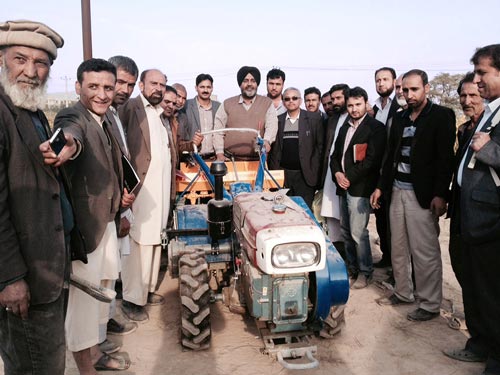CIMMYT is taking the next step in bringing Afghanistan a much-needed intervention to improve wheat research and production, an official for the country said at a meeting last month. With support from the Australian Centre for International Agricultural Research (ACIAR), CIMMYT-Afghanistan held the “Conservation Agriculture: Concept and Application” training event in Kabul from 28 to 29 October.

Thirty-five participants from the Afghanistan Agricultural Extension Project (AAEP), the Agricultural Research Institute of Afghanistan (ARIA), CIMMYT, the Food and Agriculture Organization of the United Nations (FAO), the International Center for Agricultural Research in the Dry Areas (ICARDA), Kabul University and other stakeholder organizations attended the program. Wheat accounts for 60 percent of an average Afghan’s caloric intake, but domestic wheat production falls short of the country’s needs. This happens in part because more than half of Afghanistan’s wheat is rainfed, but rainfall is often scarce and irregular in those areas. Moreover, wheat is often the sole crop for those farmers, making them food-insecure and economically vulnerable.
“Conservation agriculture is a set of practices that includes reducing or eliminating traditional tillage, keeping crop residues on the soil and using intercropping or crop rotations,” said Rajiv Sharma, senior scientist and country liaison officer for CIMMYT-Afghanistan. “Its benefits include saving resources like time, labor and fuel, as well as reducing farmers’ risk, promoting diversified cropping and more effectively capturing and retaining rainfall in the soil.”
In his inaugural speech, Mir Aminullah Haidari, deputy minister for technical affairs for Afghanistan’s Ministry of Agriculture, Irrigation and Livestock (MAIL), congratulated CIMMYT for its work in support of the country’s wheat research and production. Mohammad Qasem Obaidi, director of ARIA, welcomed the participants and thanked CIMMYT for organizing the training. Sharma said he hoped ARIACIMMYT would use the 2013-14 season to experiment with conservation agriculture interventions throughout Afghanistan.
Harminder Singh Sidhu, senior research engineer for CIMMYT, introduced the participants to different types of conservation machines available and used globally, which were imported by CIMMYT for the event. Attendees watched field demonstrations of two- and four-wheel zero tillage seed drills, raised bed planters and two-wheel tractors. H.S. Jat, CIMMYT agronomist, introduced conservation agriculture concepts, principles and procedures. He later helped wheat agronomists from six ARIA stations plan conservation agriculture experiments relevant to their local conditions. Participants expressed satisfaction and were excited to try new machines and new ways of conserving resources at their experiment stations and in farmers’ fields.
 Capacity development
Capacity development 
